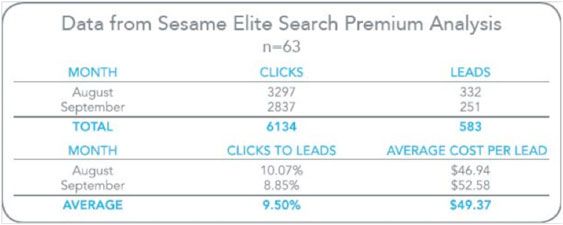How PPC advertising might attract new patients to your practice
Online marketing is becoming essential for many small businesses. Patients increasingly turn to the internet to seek and connect with service providers. The dental market has gone digital, with leading practices developing a web presence via websites and social media initiatives. This shift has made the internet a more crowded and competitive space for practices. Increasingly dentists and specialists are implementing sophisticated online promotion advertising to fortify their search engine visibility. Specifically we are experiencing a tremendous growth in online PPC advertising.
Online marketing is becoming essential for many small businesses. Patients increasingly turn to the internet to seek and connect with service providers. The dental market has gone digital, with leading practices developing a web presence via websites and social media initiatives. This shift has made the internet a more crowded and competitive space for practices. Increasingly dentists and specialists are implementing sophisticated online promotion advertising to fortify their search engine visibility. Specifically we are experiencing a tremendous growth in online PPC advertising.
What is PPC Advertising?
PPC internet advertising uses keywords and phrases targeting the right practice patient demographic and promoting a specific service mix. The advertisement text appears above the search engine results and the practice pays the search engine (for instance, Google) only when a prospective patient clicks on the link. It is important that the agency developing and placing the advertisement be Google AdWords Certified as effectiveness demands highly technical expertise.
Effective PPC advertisements go beyond good ad text and optimize results by managing the website landing pages to which prospective patients are directed from advertisement. It is important when clicking that patients do not land on your home page, but rather on the specific page relevant to the advertised service.
Impact of PPC Campaigns on Practice New Patient
The effectiveness of a paid search campaign is dependent on many factors: The process of optimizing a campaign is complex and multifaceted, and many traditional paid search management companies fail to address these aspects. The traditional method prescribes a simplistic approach of grouping many keywords into a single campaign, directing all visitors to a site’s home page, and duplicating the same ad text across all search engines. Many traditional management companies follow a simple “set it and forget it” approach, therefore ignoring continual optimization altogether.
Online advertising and search engine marketing is constantly evolving, and so it is imperative your paid advertising service provider stay on top of trends and proactively monitor campaign results and make necessary edits. An effective PPC campaign includes the use of relevant ad copy and keyword groupings, multiple ad groups per campaign, customized geo-targeting specific to a practice’s office locations, conversion optimization of landing pages and a robust call tracking system to measure lead generation. Based on quantified results and new patient tracking the practice can assess the return on investment and make the appropriate adjustments to its advertisements and budget.
Analysis of Leads Generated by PPC Google Campaigns
In November 2010, Sesame Communications conducted a 60-day review of 63 active Sesame Elite Search Premium accounts. This service develops, executes and tracks Google AdWords campaigns for dental and orthodontic practices. The study reviewed complete campaign data from August through September 2010. The study tracked call rates as well as cost per lead. In the study’s 60 day time span there were 6134 clicks and 583 total leads generated. Advertising budgets ranged from $100 to $3000 per month, with an average of $366.38. Categorization of new patients was based on caller self-identification.
Table 1: PPC Campaign Click Rate and Cost Per Lead

The Sesame Elite Search Premium study demonstrated that campaigns converted 9.5 percent of clicks into leads, based on 563 phones and 20 emails. 79 percent of callers self-identified as new patients. The average cost per lead was less than $50, compared to the national average of $275 for new patient acquisition. It is important to note that Sesame Communications tracked the call rate (leads ÷ total clicks) for PPC Google campaigns over the past two years and documented the call rate has increased 71 percent from 2009. This is likely the result of prospective patients increased level of web savvy and sophistication. Further it validates that patients clicking on advertising links are more advanced in their purchase process.
This breakthrough study of dental and orthodontic online campaigns confirms that PPC Google AdWord campaigns significantly increase phone calls and emails to the practices. Furthermore, the data was analyzed using Sesame First Call™ to track and record all calls and showed that a significant portion of the callers into the practices were self-identified as new patients.
Conclusion
In a crowded internet world PPC advertising is an effective way for a practice to appear at the top of the search engine placement. When managed effectively, PPC advertisements have the potential to grow your practice by customizing an advertising campaign based on your defined demographic, your goals, and the main products or services that you provide. Research shows that effectively executed campaigns generates leads to the practice at a low cost. The quality of those incoming leads is solid with 79 percent of the calls identified as new patients. This suggests that paid search is a valuable tool for targeting new patients. This makes intuitive sense because according to Google, when users see highly relevant ads and the ads are shown only in response to a user’s query, the user is likely to be further along in the buying cycle, and more likely to convert. As more dental and orthodontic practices move online, it becomes essential for doctors to incorporate an integrated online marketing strategy.
ACTIVA BioACTIVE Bulk Flow Marks Pulpdent’s First Major Product Release in 4 Years
December 12th 2024Next-generation bulk-fill dental restorative raises the standard of care for bulk-fill procedures by providing natural remineralization support, while also overcoming current bulk-fill limitations.